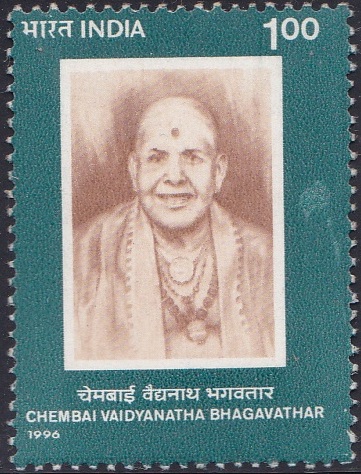
A. Vaidyanatha Iyer
A commemorative postage stamp on Madurai Vaidyanatha Ayyar, an Indian activist, spearheaded temple entry movement in Madras Presidency [a part of the series ‘Freedom Fighters and Social Reformers‘] :

 Issued by India
Issued by India
Issued on Dec 9, 1999
Issued for : The Department of Posts is happy to issue a set of stamps on these four distinguished sons of India.
Design : The first day cover design attempts to symbolise the spirit of the national movement in particular, the movement for social reform. The series pays homage to the contribution of A. Vaidyanatha Iyer, Indulal Kanaiyalal Yagnik, Dr. Punjabrao Deshmukh and P. Kakkan.
Credits :
Stamp : ISP Nashik
First Day Cover : Alka Sharma
Type : Stamp, Mint Condition
Colour : One
Denomination : 300 Paise
Overall size : 3.91 x 2.90 cms.
Printing size : 3.55 x 2.54 cms.
Perforation : 13 x 13
Paper : Imported un w/m Adhesive Gravure Coated Stamp Paper in Sheets 50.8 x 53.5 cms.
Stamps Printed : 0.7 Million
Number per issue sheet : 35
Printing Process : Photogravure
Printer : India Security Press, Nashik
Name : Vaidyanatha Iyer
Born on May 16, 1890 at Vishnampettai, Thanjavur, Madras Presidency, British India
Died on Feb 23, 1955
About :
- The Department of Posts issued a set of four stamps to pay homage to A. Vaidyanatha Iyer, Indulal Kanaiyalal Yagnik, Dr. Punjabrao Deshmukh and P. Kakkan, who apart from playing prominent roles in the Freedom Struggle, also made significant contribution through their reformist efforts towards building of the nation in the post-independence years in crucial socio-economic and political spheres.
- A. Vaidyanatha Iyer (1890-1955) threw himself in to the Freedom Struggle in 1922, influenced by Gandhiji. Playing active part in the Vedaranyam Salt Satyagraha of 1930, Quit India Movement of 1942 and many other movements, he had to spend many years in jail. He tirelessly campaigned for the development of Khadi and Village industries, prohibition, women’s welfare and removal of untouchability. In 1939, he led a group of representatives of the depressed classes who were traditionally denied entry inside temples into the famous Meenakshi temple of Madurai for offering prayers. This was an epoch making event which triggered immediate legislation for the temple-entry of Harijans. Gandhiji wrote in the “Harijan” in July, 1939 “…..a great event in the campaign against untouchability……. Shri Vaidyanatha Iyer and his co-workers deserve all praise for the ceaseless effort they have put forth in educating the public”. He led a simple and austere life and never aspired for any power or post.
- Text : Based on material supplied by sponsors.








[…] in particular, the movement for social reform. The series pays homage to the contribution of A. Vaidyanatha Iyer, Indulal Kanaiyalal Yagnik, Dr. Punjabrao Deshmukh and P. […]
[…] in particular, the movement for social reform. The series pays homage to the contribution of A. Vaidyanatha Iyer, Indulal Kanaiyalal Yagnik, Dr. Punjabrao Deshmukh and P. […]
[…] in particular, the movement for social reform. The series pays homage to the contribution of A. Vaidyanatha Iyer, Indulal Kanaiyalal Yagnik, Dr. Punjabrao Deshmukh and P. […]